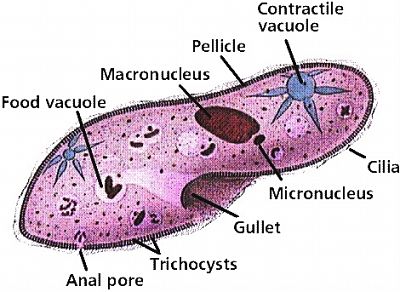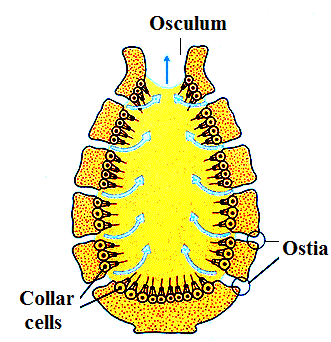Revision Notes on Phylum Protozoa and Porifera
The name “Protozoa” was coined by Goldfuss (1817). The branch of their study is called Protozoology.
 (i) Salient Features
(i) Salient Features
(1) Protozoans are the simple and primitive organisms
(2) free living or parasitic
(3) All the free living forms are aquatic
(4) asymmetrical or radially symmetrical or bilaterally symmetrical
(5) They are unicellular (acellular)
(6) They have protoplasmic grade of organization.
(7) Locomotion is affected by flagella, cilia or pseudopodia.
(8) Nutrition is holophytic, holozoic, saprozoic or parasitic.
(9) Digestion is intracellular
(10) Excretion & Respiration occurs by diffusion
(11) In fresh water protozoans osmoregulation is carried out by the contractile vacuoles.
(12) Encystment is a common phenomenon
(13) Reproduction occurs by asexual and sexual methods.
(ii) Classification of Protozoa
(a) Class 1. Flagellata or Mastigophora
(1) The body is covered by a thin pellicle or cuticle.
(2) The locomotory organs are flagella.
(3) The contractile vacuoles are present in fresh water forms with accessory vacuoles.
(4) Chloroplast is found in some forms.
(5) They may be free-living or parasitic.
(6) The class flagellata has been divided into eight orders.
(7) Examples: Chrysamoeba, Cryptomonas, Euglena, Volvox, etc.
(8) Euglena is a connecting link between Animal & Plant.
(9) Trychonymph (symbiotic) live in alimentary canal of termite that is digest to cellulose.
(b) Class 2. Rhizopoda
(1) There is no definite cell wall or pellicle
(2) There is no definite shape
(3) The locomotory organs are pseudopodia
(4) There is no permanent mouth or anus.
(5) The contractile vacuoles are present in the fresh water forms.
(c) Class 3. Ciliophora
 (1) The body is covered by thin pellicle
(1) The body is covered by thin pellicle
(2) They have a fixed permanent shape
(3) The locomotory organs are cilia
(4) Tentacles are present
(5) The class ciliophora is divided into two sub-classes, namely Ciliata and Suctoria.
Sub-class 1 - Ciliata
(1) Cilia are present throughout life.
(2) Tentacles are absent
(3) Mouth and cytopharynx are usually present.
(4) Contractile vacuoles are present.
(5) Trichocysts, organs of offense and defense are present in certain forms.
(6) Examples: Paramecium, Stylonchia Vorticella, etc., Paramecium is filter feeder
(7) In a paramecium two contractile vacuoles are present. Posterior contractile vacuole is highly active.
Sub-class 2 - Suctoria
(1) Cilia are present only in the young conditions and adults are devoid of them.
(2) Tentacles are present in the adult
(3) One to many contractile vacuoles are present
(4) Examples: Acineta, Dendrocometes, Dendrosoma, etc.
(d) Class 4 - Sporozoa
(1) They are exclusively endoparasitic
(2) The body is covered by pellicle.
(3) Reproduction takes place by spore formation
(4) The class is divided into two sub-classes, namely, Telosporidia and Neosporidia
Sub-class 1 - Telosporidia
(1) The spores do not contain polar capsules or filaments
(2) The life history ends with the formation of spores.
(3) The spore cases are simple and contain many spores
(4) Examples: Monocystis, Gregarina, Isopora, Eimeria, Plasmodium, Babesia, etc.
Sub class 2 - Neosporidia
(1) The trophozoite is amoeboid multinucleated
(2) Spore cases are complex usually having a single germ
(3) Examples: Nosema, Myxidium, Globidium, etc.
Phylum Porifera
 (i) The word “Porifera” means pore bearers (Gr., porus = pore; ferre = to bear); their body wall has numerous minute pores, called ostia, through which a continuous current of outside water is drawn into the body.
(i) The word “Porifera” means pore bearers (Gr., porus = pore; ferre = to bear); their body wall has numerous minute pores, called ostia, through which a continuous current of outside water is drawn into the body.
(ii) Phylum porifera has the following salient features:
(1) All the sponges are Aquatic, Sedentary, Asymmetrical or Radially,
(2) They are diploblastic.
(3) The body is perforated by numerous minute pores called ostia.
(4) The ostia open into a large cavity called spongocoel.
(5) The spongocoel opens to the outside by a large opening called osculum.
(6) The sponges possess an endoskeleton in the form of calcareous spicules.
(7) Excretion and respiration occur by diffusion.
(8) They have greater power of regeneration.
(9) Reproduction takes place by asexual or sexual methods.
(10) Development is indirect or direct. The common larval are parenchymula, amphiblastula, etc.
(a) Class 1. Calcarea
(1) Skeleton is formed of Calcareous spicules.
(2) Radially symmetrical.
(3) Choanocyte cells are large and conspicuous. Examples: Clathrina, Leucosolenia, Sycon, etc.
(4) Euplectela is the sponge which is given as a Gift in Japan.
(5) Leucosolenia is a smallest sponge.
(6) Ectorderm is formed by pinachocyte and endoderm is formed by choanocyte.
(b) Class 2. Hexactinellida 
(1) Skeleton is formed of six rayed triaxon, silicious spicules.
(2) Canal system is branched or unbranched.
(3) Radially symmetrical.
(4) These are also known as glass sponges.
(5) Examples: Pheronema, Hyalonema, etc.,
(6) Hylonema is a Glass rope sponge.
(c) Class 3. Demospongia
(1) Skeleton either absent or present.
(2) The silicious spicules when present are never six rayed
(3) The canal system is complicated Rhagon type
(4) These sponges are of great economic importance
(5) Examples: Cliona, Spongilla, Chalina, Euspongia, Hippospongia, Oscarella, etc.
(6) Spongilla is a fresh water sponge.
View courses by askIITians


Design classes One-on-One in your own way with Top IITians/Medical Professionals
Click Here Know More

Complete Self Study Package designed by Industry Leading Experts
Click Here Know More

Live 1-1 coding classes to unleash the Creator in your Child
Click Here Know More

a Complete All-in-One Study package Fully Loaded inside a Tablet!
Click Here Know MoreAsk a Doubt
Get your questions answered by the expert for free